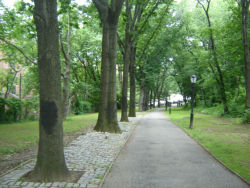Fort Independence Playground
Fort Independence Playground
The American Revolution (1763-1789), the fight for our nation's independence from British rule, irrevocably shaped the course of American history and physically transformed the colonial landscape. Evidence of Revolutionary War action is imprinted on New York City from the Battery in Manhattan to Fort Greene in Brooklyn, from Newtown Creek in Queens to Port Richmond in Staten Island. The Bronx neighborhood of Kingsbridge, so named for the first bridge connecting Manhattan with the mainland in 1693, was strategically important during the Revolution in the New York Campaign and subsequently in the British defense of the city.
As Commander-in-Chief of the Continental Army, General George Washington ordered the construction of outer defenses throughout the Kingsbridge area. Fort Independence was built under the direction of Colonel Rufus Putnam in 1776 to protect the American army and to safeguard the line of the Harlem River. An entrenchment ten feet wide and three and a half feet deep surrounded the austere fort. From its elevated position, the site commanded an extensive prospect of the surrounding countryside. In the fall of 1779, the fort was destroyed by British forces led by Sir Henry Clinton.
The site has had other historic uses. The Jerome Park Racetrack occupied the site from 1876 to 1890. The track was closed to accommodate the Jerome Park Reservoir which was filled first in 1905, holding 773 million gallons of water. The racetrack and reservoir take their name from Leonard W. Jerome (1817-1891), founder of the American Jockey Club. For years, he was the principal owner of the New York Times and supported the arts, establishing the Academy of Music. His daughter, Jennie Jerome, was the wife of Randolph Churchill and the mother of Winston Churchill.
This property was acquired by condemnation in 1895 as part of the Jerome Park Reservoir, and was placed under the jurisdiction of the Department of Parks in 1915. In the same year, several cannon balls were unearthed at the site of Fort Independence, known as Giles Place. They were identified as remnants of George Washington's command at the fort. The park property was named Fort Independence Park in honor of this historic discovery. The Daughters of the Revolution dedicated a plaque in memory of the officers and soldiers of the Continental Army in 1916.
Early plans of Fort Independence Park indicate a playground complete with basketball courts, swings, playhouses, shower basin, public restrooms, flagpole and overlook. The area was rehabilitated and the playground reconstructed during the latter part of 1956 to include a sandpit, seesaw, kindergarten swings and slide, basketball and handball courts, and bicycle path. In 1997 Fort Independence Park was reconstructed under a requirements contract funded by Mayor Giuliani. New features include play equipment, safety surfacing, paving, and a flagpole.
Check out your park's Vital Signs
Clean & Safe
Green & Resilient
Empowered & Engaged Users
Share your feedback or learn more about how this park is part of a
Vital Park System



